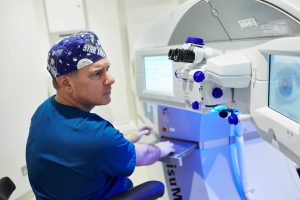The Complete History of Laser Eye Surgery

Laser Eye Surgery has quickly become the most popular elective surgery worldwide. But while the procedure we are familiar with today – complete with state-of-the-art technology – was only invented a few decades ago, the concept behind Laser Eye Surgery goes back much further. We’re taking a look at the full history of the treatment, from its inception to the modern day.
With over 100,000 procedures performed annually in the UK alone, Laser Eye Surgery is the single most common operation around the world. From its grizzly origins, the procedure can now be performed in a matter of minutes, correcting around 97% of all refractive errors.
But, where did this innovative and life-changing treatment come from?
It is the confluence of numerous brilliant ideas and bio-engineering accomplishments that have led to what is one of the most miraculous medical procedures in the history of medicine. So, let’s take a look at the origin story of Laser Eye Surgery.
Barraquer Develops Keratomileusis – 1948
In the middle of the 20th century, Spanish ophthalmologist Jose Ignacio Barraquer Moner developed a procedure which he named “keratomileusis” (the ‘K’ in LASIK) – literally meaning “cornea” and “carve”. As the name suggests, Barraquers theory was that refractive errors could be corrected by reshaping the cornea.
To achieve this, Barraquer used a manually driven microkeratome to remove a disc of anterior corneal tissue. This tissue was then dipped in liquid nitrogen and milled on a watchmaker’s lathe to change the curvature of the cornea. Barraquer invented a number of tools for his procedure, including the antitorque suture and an operating microscope used for reattaching the reshaped corneal disc to the patient’s eye.
Barraquer’s first patients were successfully treated in the early 1960s. Around the same time, others around the world were experimenting with Barraquer’s theory, including Krwawicz in Poland who, in 1964 published a paper describing a series of three highly myopic eyes in which he had performed a “stromectomy”.
Some thousands of keratomileusis procedures were carried out at Barraquer’s clinic in (the Instituto de America) in Bogota in the 1960s, 70s and 80s and surgeons from around the world came to learn this difficult, but miraculous technique.
Refining Barraquer’s Technique
In 1986, two of these surgeons published a paper describing a keratomileusis technique that did not require freezing the cornea. This became known as the Barraquer-Krumeich-Swinger (BKS) technique.
Further refinements were made. Luis A. Ruiz, who had completed his residency at the Barrquer Institute first performed an in-situ (the ‘I’ in LASIK) keratomileusis. Ruiz designed a gear system to automate the passage of the microkeratome head. This helped to avoid irregular resections and greatly improved accuracy – it become known as Automated Lamellar Keratoplasty (ALK).
In 1989 Ruiz presented a paper demonstrating how stopping the microkeratome could be used to create a corneal flap. This allowed access to the stromal tissue underneath without the complete removal of the corneal disc.
These changes represented significant improvements in the world of refractive surgery. But when did eye surgery become Laser Eye Surgery?
Introducing the Laser
In the early 1990s, in-situ keratomileusis was combined with the emerging technology of excimer lasers for corneal tissue ablation. Let’s take a look at the establishment of the PRK criteria which paved the way for laser-assisted in-situ keratomileusis (LASIK) as we know it today.
In 1952, Einstein’s 1917 theory of stimulated emission was harnessed in the creation of the microwave amplification of stimulated emission of radiation – or MASER. Later, microwaves were replaced by light and the MASER became LASER, as first defined by Gordon Gould in 1957.
Almost a quarter of a century later, an Argon-Fluoride excimer laser was tested on organic tissue as researchers used the laser to create an incision in the cartilage of a leftover Thanksgiving turkey. They found no damage to the surrounding tissue. This finding was supported by those of Taboada, who also found no thermal damage to the remaining tissue after placing a 248-nanometer excimer laser pulse onto corneal epithelium.
Having seen Taboada’s work, S L Trokel, wanted to investigate the potential of using their excimer laser to improve the accuracy of radial keratotomy incisions. In 1985, Trokel began working with J Marshall to study the ultrastructural aspects of corneal photoablation. Their findings indicated that large-area ablation could be performed in the central cornea, rather than just for peripheral linear incisions. This was described as photorefractive keratectomy (PRK).
For PRK to become a feasible procedure in human eyes, the following criteria needed to be satisfied:
- The depth of tissue removal required for a given refraction change must be known. Munnerlyn proposed an algorithm adapted from Barraquer’s earlier formulae to calculate the ablation profile as a function of refractive error and optical zone diameter.
- The quality and clarity of the ablated surface must be preserved: Earlier studies in rabbit corneas demonstrated only limited haze after a large area ablation. Myopic ablation on a donor eye also showed that the ablated surface was clean and smooth.
- The wound-healing process must not result in scarring: It was already known that there is no scarring after radial incisions. Then, Marshall demonstrated no changes in corneal transparency 8 months after PRK in 12 monkey corneas, and McDonald reported stable dioptric change in a primate cornea with good healing and long-term corneal clarity up to one year after PRK.
In early 1988, Mcdonald performed the first PRK procedure on a sighted eye due for enucleation. At this time, a number of methods were being used for central surface ablation of the cornea. The success of these first PRK cases prompted larger clinical trials and the commercial availability of excimer lasers.
In 1991, McDonald reported that myopic PRK treatment with the VISX 20/20 system was safe. Around the same time, others (Lindstrom and Gartry) demonstrated the efficacy of the Taunton Technologies model LV 2000 excimer laser for myopic PRK and the Summit Technology Eximed UV200 excimer laser. In 1993, Dausch and Schroeder presented the first hyperopic ablation profiles.
It is around this time that the excimer laser was combined with keratomileusis to give us Laser In-situ Keratomileusis or LASIK.
The Arrival Of LASIK
In December 1989, Buratto had a patient whose corneal cap was too thin for the required tissue removal. He decided instead to perform the excimer laser ablation directly on the stromal bed.
At around the same time, Pallikaris also independently conceived of a hinged flap using a microkeratome he had specifically designed for rabbit studies. He performed the ablation with an excimer laser on the exposed bed and replaced the flap without sutures. Pallikaris first used the term LASIK in his 1991 paper.
It is this technique, which gave birth to what is now the most commonly performed surgical procedure in the world and realised the dreams of Jose Ignacio Barraquer Moner 40 years in the making.
LASIK remains the most commonly performed Laser Eye Surgery procedure to this day. However, innovative new treatments – including ReLEx SMILE – continue to advance Laser Eye Surgery treatment in the UK and around the world.
If you’d like to learn more about Laser Eye Surgery and whether it’s right for you, get in touch or Book a Consultation today.


